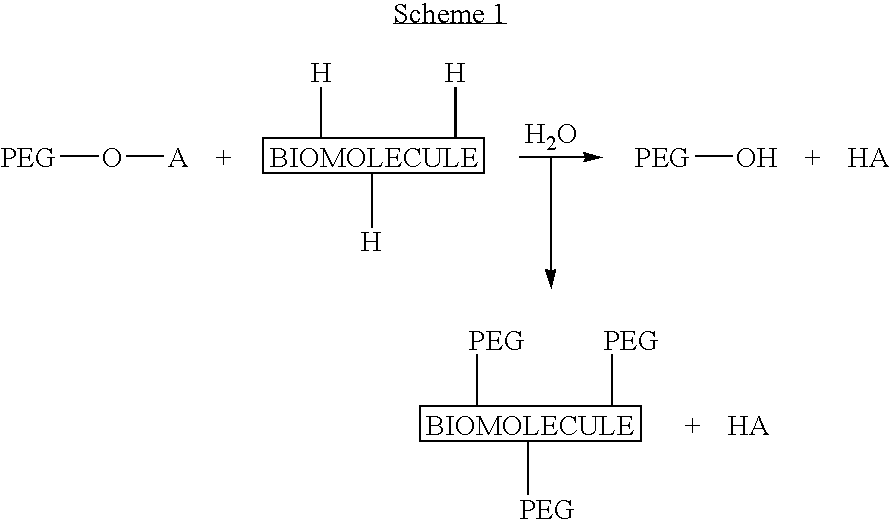Activated polyethylene glycol compounds
a technology of polyethylene glycol and active ingredients, which is applied in the direction of amide active ingredients, chemical vapor deposition coatings, peptides, etc., can solve the problems of inefficient process of pegylation of certain biomolecules, increased workup and purification, and reduced kidney clearance and spurious enzymatic degradation and immune system recognition, etc., to achieve rapid and efficient pegylation, enhance physiological properties, and improve the effect of acylation efficiency
- Summary
- Abstract
- Description
- Claims
- Application Information
AI Technical Summary
Benefits of technology
Problems solved by technology
Method used
Image
Examples
example 1
Synthesis of 4-Carboxyphenyl Isothiocyanate
[0099]Para-aminobenzoic acid (0.2 moles; 26 grams of 99 percent pure from Aldrich Chemical, Milwaukee, Wis.) was dissolved in acetone (400 mL) at room temperature (about 20 degrees Celsius). Activated carbon (about 5 grams; Darco® G60) was added, and the mixture was stirred (magnetic stir bar) for 5 to 10 minutes. The entire solution was filtered, yielding a much lighter-colored solution of p-aminobenzoic acid than was initially formed.
[0100]Sodium acetate (0.3 moles, 25 grams; dissolved in about 200 mL of deionized water) was added to the filtrate, now contained in a 4 liter vacuum flask. A vacuum was applied to the flask with an intermediate dry ice / acetone trap between the 4 liter flask and the vacuum pump. Reduced pressure was maintained until much of the original acetone had evaporated off of the p-aminobenzoic acid solution (down to about 300 mL volume). The flask was chilled to between about zero and five degrees Celsius.
[0101]Thioph...
example 2
Synthesis of 4-Isothiocyanobenzoyl Azide
[0104]A portion of the 4-carboxyphenyl isothiocyanate (15 grams) from Example 1 was suspended in dry methylene chloride (200 mL) in a 1 liter side-arm vacuum flask, along with pyridine (16 grams; 0.2 M), phenyl dichlorophosphate (Aldrich Cat. No. P.2, 238-9; 0.1 M) and sodium azide (6.5 grams; 0.1 M). The mixture was stirred overnight (about 15 hours) at room temperature. The stirred mixture was then washed in a separatory funnel with water (200 mL) and then sulfuric acid (200 mL of 0.1 N H2SO4). The acid-washed methylene chloride layer was dried with anhydrous magnesium sulfate (MgSO4).
[0105]The dried methylene chloride reaction solution was evaporated under vacuum in a rotary evaporator at room temperature or lower (less than or equal to about 20° C.). The resulting light tan crystals were dissolved in a minimum of ethyl ether at room temperature. The re-crystallization solution was treated with activated carbon (Darco® G60) and filtered. Th...
example 3
Synthesis of 4-Isothiocyanophenyl Isocyanate and PEG Reagent
[0107]The nearly white 4-isothiocyanobenzoyl azide from Example 2 was thermally decomposed at about 75°–104° C. (Curtius Rearrangement) smoothly and quantitatively as a solution in dry refluxing toluene. The resulting 4-isothiocyanophenyl isocyanate (also known as 4-isocyanophenyl isothiocyanate, shown below) product is represented by the following chemical formula. The 4-isocyanophenyl isothiocyanate was not isolated, but reacted as formed in situ with the hydroxyl-containing PEG according to the following description. An infrared spectrum of the composition containing 4-isocyanophenyl isothiocyanate showed the decrease in the azide band at about 980–1000 cm−1 along with increased complexity of the absorbance in the N═C═O and N═C═S region of the spectrum from about 2000 to about 2300 cm−1.
[0108]
[0109]A 2-liter, 3-necked flask was equipped with a thermometer, overhead stirrer with motorized drive, heating mantle with rheost...
PUM
| Property | Measurement | Unit |
|---|---|---|
| dwell time | aaaaa | aaaaa |
| temperature | aaaaa | aaaaa |
| volume | aaaaa | aaaaa |
Abstract
Description
Claims
Application Information
 Login to View More
Login to View More - R&D
- Intellectual Property
- Life Sciences
- Materials
- Tech Scout
- Unparalleled Data Quality
- Higher Quality Content
- 60% Fewer Hallucinations
Browse by: Latest US Patents, China's latest patents, Technical Efficacy Thesaurus, Application Domain, Technology Topic, Popular Technical Reports.
© 2025 PatSnap. All rights reserved.Legal|Privacy policy|Modern Slavery Act Transparency Statement|Sitemap|About US| Contact US: help@patsnap.com



